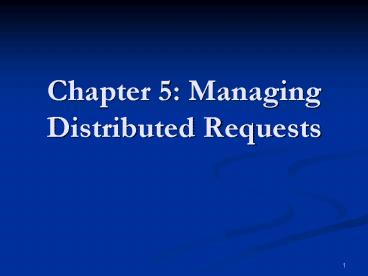Chapter 5: Managing Distributed Requests - PowerPoint PPT Presentation
1 / 27
Title:
Chapter 5: Managing Distributed Requests
Description:
Distributed Execution Models. 3. Data Transparency. User Interface. Global Transaction ... Ackman 5000 Car. Baker 4500 Car. Carson 4800 Toy. Davis 5100 Toy ... – PowerPoint PPT presentation
Number of Views:16
Avg rating:3.0/5.0
Title: Chapter 5: Managing Distributed Requests
1
Chapter 5 Managing Distributed Requests
2
Managing Distributed Requests
- Data Transparency
- Distributed Execution Models
3
Data Transparency
4
Data Transparency, cont.
- Users are isolated from underlying data
structures. - User is not aware of underlying data structures.
- Underlying data structures can be changed without
changing existing transactions. - Types of data transparency
- Data structure data independence of
centralized DBMSs - Existence of fragments fragmentation
transparency - Location of fragments location transparency
- Replication of fragments replication
transparency
5
Fragmentation and Allocation Example
fragmented
Store at site 1
Store at site 2 Store at site 3
6
No Fragmentation, Replication, or Location
Transparency
- User is aware of fragments, replication, and
location. - To retrieve Daviss salary
select Salary from Employee1 at Site1 where
Name"Davis" UNION select Salary from Employee1
at Site1 where Name"Davis"
7
No Fragmentation Transparency, But Replication
and Location Transparency
- User is aware of fragments
- To retrieve Daviss salary
location hidden
location and replication hidden
select Salary from Employee1 where
Name"Davis" UNION select Salary from
Employee2 where Name"Davis"
8
Total Transparency
- User is only aware of unfragmented table
- To retrieve Daviss salary
EmployeeEmployee Name Employee Salary
Department NameAckman
5000 Car Baker 4500
CarCarson 4800 ToyDavis
5100 Toy
(fragments and their replications and locations
are hidden)
select Salary from Employee1 where Name"Davis"
9
Complex Example
update Employee set Department15 where EmpId100
More
10
Complex Example, cont.
- select Name,Sal,Tax, into Name,Sal,Taxfrom
Employee1where EmpId100 - select ManagerNumber into ManagerNumberfrom
Employee2where EmpId100 - insert into Employee3 (EmpId,Name,Department)
(100,Name,15) - insert into Employee4 (EmpId,Sal,Tax,ManagerNumbe
r)
(100,Sal,Tax,ManagerNumber) - delete Employee1 where EmpId100delete
Employee2 where EmpId100
11
Summary Fragmentation, Replication, and Location
Transparency
- Advantages
- Easier to write transactions
- Less modification of existing transactions when
- Fragmentation changes
- Fragment replication changes
- Fragment location changes
- Disadvantage
- Overhead of global query optimizer
12
Managing Distributed Requests
- Data Transparency
- Distributed Execution Models
13
Distributed Execution Models
14
Distributed ExecutionPlan Example
- Transaction
- Allocation information
- Global execution plan
Read X Read Y Read Z Report XYZ to user
Read X from DB1 Read Y from DB2 Read Z from
DB3 Calculate XYZ Report XYZ
Subtransactions to beexecuted at different sites
More
15
Distributed Execution Plan Example, cont.
- Global execution plan
RX
RZ
RY
X
Z
Y
Report XYZ
Rx means Read x
16
Services Needed
- Remote process activation
- Process synchronization
- Interprocess temporary data transfer
- Remote process deactivation
17
Three Approaches
- Master/Slave control
- Triangular control
- Hierarchical control
18
Master/Slave Approach Participants
- One global execution manager
- Acts as master
- One or more local execution manager
- Act as slaves
19
- Distributed execution plan
C Command R Response
20
Master/Slave ExampleSDD-1 (CCA)
- Distributedexecution plan
Read
Read
Read
. . .
Data
Data
Data
Write
Write
Write
. . .
Done
Done
Done
TM Transaction Manager DM Data Manager
21
Summary Master/Slave Approach
- Advantages
- Simple
- Global execution coordination controls all
synchronization. - Disadvantages
- When intermediate results are needed by another
local execution monitor, they must first be
transmitted to the global execution monitor.
22
Triangular Control
- Distributed execution plan
Distributed ExecutionManager
C
C
R
R
Local ExecutionManager
Local ExecutionManager
Temporary Data
. . .
23
Triangular Example DDTS (Honeywell)
- Distributed execution plan
Source Rahimi, S., et al. A Structured View of
Honeywells Distributed Database Test-bed
System. IEEE Database Engineering (December
1982).
24
Summary Triangular Control
- Advantages
- No unnecessary data transmission between the
global execution manager and local execution
manager - Disadvantages
- Some synchronization is necessary among local
execution managers.
25
Hierarchical Example System R (IBM)
- Distributed execution schedule
Distributed ExecutionManager
C
C
R
R
Local ExecutionManager
Local ExecutionManager
. . .
C
C
C
C
R
R
R
R
Local ExecutionManager
Local ExecutionManager
. . .
. . .
26
Summary Hierarchical Control
- Advantage
- Permits incremental planning each local
execution manager acts as a global execution
manager - Disadvantage
- Complexity
27
Summary
- Distributed Execution Model Control
- Master/Slave control Centralized
- Triangular control Shared
- Hierarchical control Distributed































